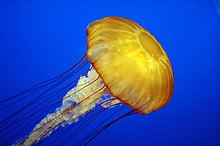
Back Kwalle Afrikaans قنديل بحر Arabic Meduza Azerbaijani دنیزآناسی AZB Медузы Byelorussian Медузи Bulgarian जेलीफिश Bihari জেলিফিশ Bengali/Bangla Bloneg-mor Breton Medusa Catalan
| Jellyfish | |
|---|---|

| |
| Pacific sea nettle (Chrysaora fuscescens) | |
| Scientific classification | |
| Domain: | Eukaryota |
| Kingdom: | Animalia |
| Phylum: | Cnidaria |
| Subphylum: | Medusozoa |
| Groups included | |
| Cladistically included but traditionally excluded taxa | |
Jellyfish, also known as sea jellies, are the medusa-phase of certain gelatinous members of the subphylum Medusozoa, which is a major part of the phylum Cnidaria.
Jellyfish are mainly free-swimming marine animals with umbrella-shaped bells and trailing tentacles, although a few are anchored to the seabed by stalks rather than being mobile. The bell can pulsate to provide propulsion for efficient locomotion. The tentacles are armed with stinging cells and may be used to capture prey and defend against predators. Jellyfish have a complex life cycle. The medusa is normally the sexual phase, which produces planula larvae. These then disperse widely and enter a sedentary polyp phase which may include asexual budding before reaching sexual maturity.
Jellyfish are found all over the world, from surface waters to the deep sea. Scyphozoans (the "true jellyfish") are exclusively marine, but some hydrozoans with a similar appearance live in freshwater. Large, often colorful, jellyfish are common in coastal zones worldwide. The medusae of most species are fast-growing, and mature within a few months then die soon after breeding, but the polyp stage, attached to the seabed, may be much more long-lived. Jellyfish have been in existence for at least 500 million years,[1] and possibly 700 million years or more, making them the oldest multi-organ animal group.[2]
Jellyfish are eaten by humans in certain cultures. They are considered a delicacy in some Asian countries, where species in the Rhizostomeae order are pressed and salted to remove excess water. Australian researchers have described them as a "perfect food": sustainable and protein-rich but relatively low in food energy.[3]
They are also used in research, where the green fluorescent protein used by some species to cause bioluminescence has been adapted as a fluorescent marker for genes inserted into other cells or organisms.
The stinging cells used by jellyfish to subdue their prey can injure humans. Thousands of swimmers worldwide are stung every year, with effects ranging from mild discomfort to serious injury or even death. When conditions are favourable, jellyfish can form vast swarms, which can be responsible for damage to fishing gear by filling fishing nets, and sometimes clog the cooling systems of power and desalination plants which draw their water from the sea.
- ^ "Fossil Record Reveals Elusive Jellyfish More Than 500 Million Years Old". ScienceDaily. Retrieved 10 February 2023.
- ^ Angier, Natalie (6 June 2011). "So Much More Than Plasma and Poison". The New York Times. Archived from the original on 18 May 2013. Retrieved 2 December 2011.
- ^ Isabelle Rodd (20 October 2020). "Why jellyfish could be a 'perfect food'". BBC News. Retrieved 7 May 2023.
© MMXXIII Rich X Search. We shall prevail. All rights reserved. Rich X Search